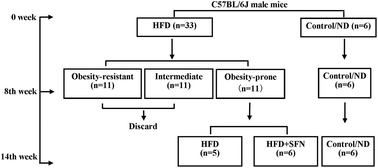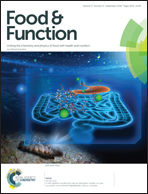Sulforaphane ameliorates glucose intolerance in obese mice via the upregulation of the insulin signaling pathway
Abstract
Sulforaphane (SFN) is a dietary component with multiple bioactivities; however, its role in obesity-related metabolic derangement remains unclear. Here, the effect of SFN on the glucose intolerance of obese mice and the underlying mechanism were determined. C57B/6J male mice were randomly divided into two groups, having free access to water and a normal-fat diet (ND, n = 6) or a high-fat diet (HFD, n = 33) for 8 weeks; thereafter twelve mice having the greatest weight gain among the HFD-fed mice were considered as obese mice. These obese mice were randomly divided into two groups and treated orally for 6 weeks with or without SFN (100 μmol per kg bw, 3 times per week). During this period the animals were continuously maintained on a ND or a HFD. Blood glucose and serum insulin were examined; then glucose tolerance and insulin resistance were evaluated. In addition, the expression of insulin signaling pathway-related genes in the muscle was determined. Our data showed that the obese mice presented a marked insulin resistance and glucose intolerance as compared to the control group, while SFN treatment exerted a prominently protective effect. In addition, the SFN-treated obese mice had a significantly increased insulin receptor substrate 1 (IRS-1) protein level (P < 0.05), markedly elevated Akt activation, as well as dramatically enhanced phosphorylation of PDK-1 (P < 0.05) when compared with the SFN-untreated obese mice. Moreover, the SFN-treated obese mice exhibited a significantly enhanced translocation of GLUT4 (P < 0.05) to the plasma membrane in the muscle compared to the obese mice without SFN treatment. In conclusion, our results support the notion that SFN acts as a promising agent to improve glucose tolerance through the up-regulation of insulin signaling mainly involving the IRS-1/Akt/GLUT4 pathway in the muscle.



 Please wait while we load your content...
Please wait while we load your content...